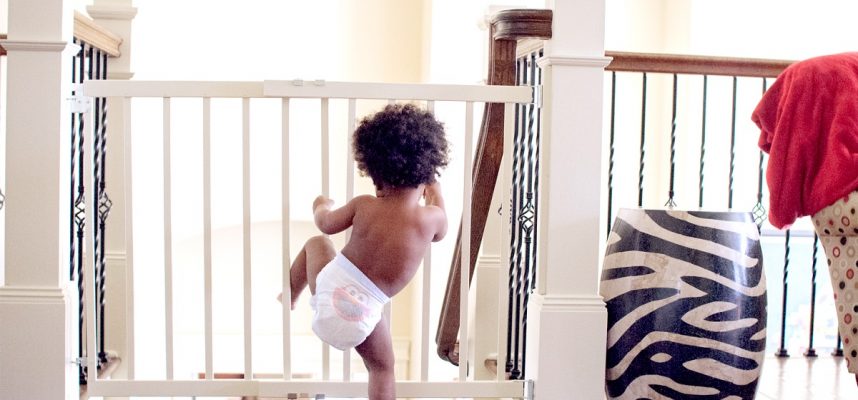
Babyproofing checklist
On average, babies start to crawl at 8 months, which means many get moving even earlier. A crawling baby will soon start pulling up, too, which means counters and other surfaces are no longer out of reach. Use this checklist to help you prepare for a kid who can go from here to there in the blink of an eye. Then crawl around on your hands and knees to see if you’ve missed anything.
Not all safety measures need to be in place by the time baby comes home from the hospital. But before the first six months are up, you’ll need to make sure to baby-proof with some basic safeguards installed in the following areas of your home:
Part 1 – The Home Basics
Stairways: Install baby gates at the top and bottom. Never use a pressure-mounted baby gate at the top of the stairs, because it may fail. Instead, opt for the wall-mounted variety.
Window blinds: Trim (or better yet, remove) cords altogether to make sure they will be out of reach for years to come.
Windows: If your windows are older, install child-proof locks. Never leave a child unattended around an open window — not even one with a screen, because it can’t support a child’s weight.
Outlets: Insert plastic guards into all sockets below hip level. For often-used outlets, consider sliding outlet covers for easier access.
Doors: When baby starts walking, install knob guards on the bathroom door and any door leading outside. Also, plastic guards that fit over the top of accordion doors will prevent pinched or cut fingers.
Bathroom: A toilet seat lock is a must, but for further protection, always keep your bathroom door closed when possible. Faucet covers on the bathtub will keep baby’s mouth and head safe in case of a slip. Apply nonslip mats for extra precaution. And, of course, never leave your child unattended around water. To prevent burns, make sure your water heater is set to 120 degrees or less.
Kitchen: Install cabinet locks, door locks, and oven knob covers to make it impossible for a child to turn on the burners. Add straps to the oven door to keep a child from opening it. Cook on the back burner when baby is present. Put adhesive locks on the refrigerator (and the freezer, if it’s within reach).
Sharp edges: On tables, countertops, and your bed, apply corner and table edge cushions to prevent head lacerations that often require stitches.
Part 2 – The Other Pieces You would Miss
Bathing
- Fill tub just enough to cover your baby’s legs (2 to 3 inches of water).
- Use warm, not hot, water (do wrist test or use thermometer to make sure water is 96 to 100 degrees Fahrenheit).
- Never, ever leave babies in tub unsupervised, not even for a few seconds.
- Put nonslip mats in bathtub and on the floor next to the tub.
Nice to have:
- Soft cover for bathtub spout.
- Covers for bathtub knobs.
- Bathtub ring for babies to sit in. (Not a substitute for supervision!)
Preventing burns
- Don’t carry hot food or drink and your baby at the same time.
- Keep hot food and drink away from edges of tables and counters.
- Don’t hold your baby while cooking at stove.
- Turn pot handles toward back of stove.
- Secure oven door with an appliance latch.
Nice to have:
- Plastic stove guard that blocks access to burners; knob covers.
Car
- Keep children in rear-facing car seat until age 2, or until they reach the maximum height and weight for their seat.
- Install car seat properly, in rear-facing position in middle of backseat.
Preventing falls
- Never leave your baby alone on beds or sofas, in bouncy chair or highchair, on changing table, or in any other spot he could fall from.
- Use window guards, window stops, and safety netting on windows, decks, and landings.
- Cut looped window-blind cords; use safety tassels and cord stops.
- Install gates to block stairways at bottom and top.
- Block openings wider than 4 inches on railings with plastic garden fencing, Plexiglas, or other material.
- At the store, use safety belt on shopping cart (or bring one of your own).
Poison-proofing
- Move cleaning agents, medicines, hand sanitizer, vitamins, toiletries, mothballs, and other potentially toxic items out of reach or lock them up.
- Your purse or a visitor’s purse can hold medicines, toiletries, and other dangers — move out of reach.
- Get rid of toxic houseplants such as philodendron or move them out of reach.
Water safety
- Don’t leave babies unattended even for a moment in or near a pool or other water.
- Erect fencing around pools at least 4 feet high with a self-closing, self-latching gate.
- Empty wading pools and store upright after each use.
- Don’t leave even small amounts of water, cleaning solutions, or other liquids in buckets or other containers.
Remember safety is a constant concern: Don’t just do these steps once and forget about them. Be sure to do safety checks everywhere your little mover goes. (You know your mother-in-law will love your safety additions to her kitchen!) Your little one’s sense of adventure is growing daily and so are her abilities to get into mischief. Always be on alert. And, why not assign one day a week to do a top to bottom safety once over with baby’s newly learned skills in mind. How about Safety Saturday?
And, keep in mind every home has special features that are unique as well as common safety challenges. The above are solutions to common safety hazards found in most homes. Now let the learning through exploration begin and enjoy this precious time!

